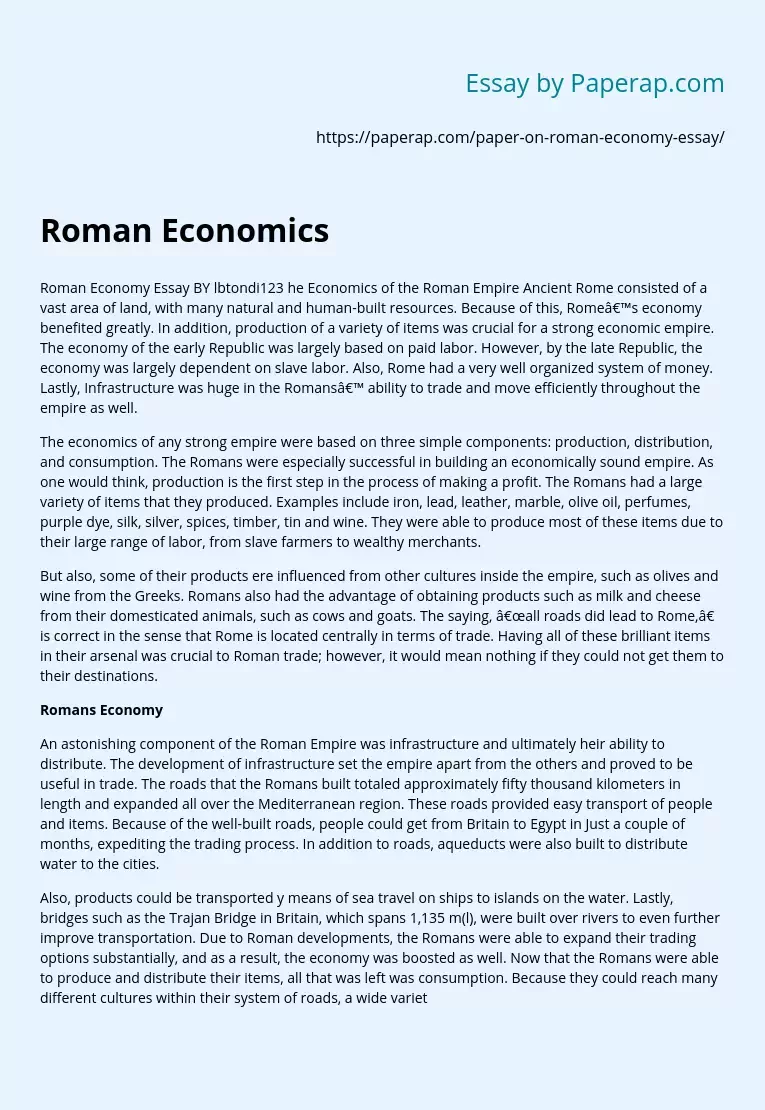Roman Economics
Roman Economy Essay BY lbtondi123 he Economics of the Roman Empire Ancient Rome consisted of a vast area of land, with many natural and human-built resources. Because of this, Rome’s economy benefited greatly. In addition, production of a variety of items was crucial for a strong economic empire. The economy of the early Republic was largely based on paid labor. However, by the late Republic, the economy was largely dependent on slave labor. Also, Rome had a very well organized system of money.
Lastly, Infrastructure was huge in the Romans’ ability to trade and move efficiently throughout the empire as well.
The economics of any strong empire were based on three simple components: production, distribution, and consumption. The Romans were especially successful in building an economically sound empire. As one would think, production is the first step in the process of making a profit. The Romans had a large variety of items that they produced. Examples include iron, lead, leather, marble, olive oil, perfumes, purple dye, silk, silver, spices, timber, tin and wine.
They were able to produce most of these items due to their large range of labor, from slave farmers to wealthy merchants.
But also, some of their products ere influenced from other cultures inside the empire, such as olives and wine from the Greeks. Romans also had the advantage of obtaining products such as milk and cheese from their domesticated animals, such as cows and goats. The saying, “all roads did lead to Rome,” is correct in the sense that Rome is located centrally in terms of trade.
Having all of these brilliant items in their arsenal was crucial to Roman trade; however, it would mean nothing if they could not get them to their destinations.
Romans Economy
An astonishing component of the Roman Empire was infrastructure and ultimately heir ability to distribute. The development of infrastructure set the empire apart from the others and proved to be useful in trade. The roads that the Romans built totaled approximately fifty thousand kilometers in length and expanded all over the Mediterranean region. These roads provided easy transport of people and items. Because of the well-built roads, people could get from Britain to Egypt in Just a couple of months, expediting the trading process. In addition to roads, aqueducts were also built to distribute water to the cities.
Also, products could be transported y means of sea travel on ships to islands on the water. Lastly, bridges such as the Trajan Bridge in Britain, which spans 1,135 m(l), were built over rivers to even further improve transportation. Due to Roman developments, the Romans were able to expand their trading options substantially, and as a result, the economy was boosted as well. Now that the Romans were able to produce and distribute their items, all that was left was consumption. Because they could reach many different cultures within their system of roads, a wide variety of people lead to an increase of supply and demand.
The Romans themselves were also consumers. Imports such as silks from China, cotton and spices from India, ivory and wild animals from Africa, large amounts of world were received by the Romans. In fact, “There was no luxury that the ancient world had to offer that the Romans didn’t accept themselves”(Hardy). On the contrary, these luxuries were only financially available to the wealthy; so, those that were not as wealthy were not able to obtain these luxury imports. The action of obtaining such a large diversity of items from others proved to be helpful in the Roman Empire.
Overall, the ancient Roman Empire had all of the key components of economic success. The Romans created a wide variety of items and goods, even creating their own currency system. The infrastructure they created gave them the advantage when it came to distributing product and transportation altogether. In addition, their central location in the large Mediterranean region allowed their range of distribution to be enormous thus, increasing consumption. With the three components of economics: production, distribution, and consumption, the Romans were able to create a superior empire that thrived economically.
Roman Economics. (2019, Dec 05). Retrieved from https://paperap.com/paper-on-roman-economy-essay/

